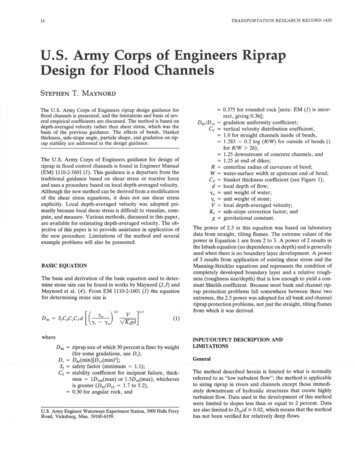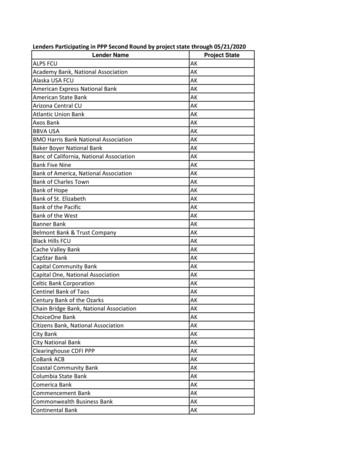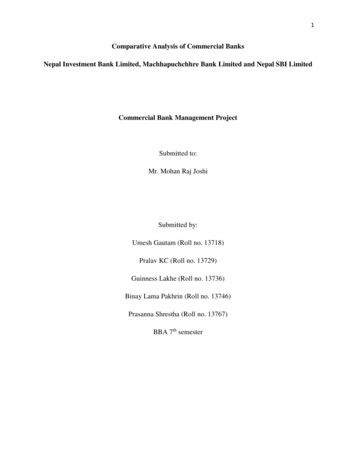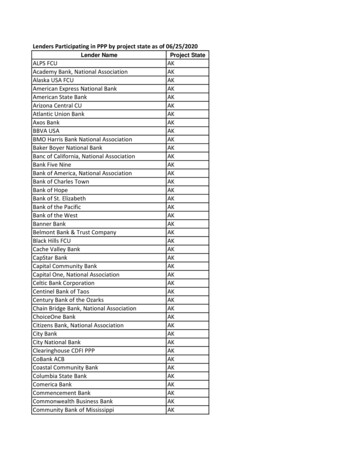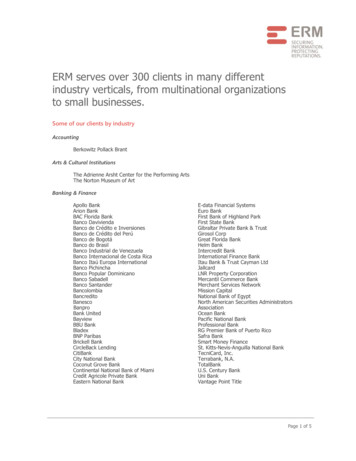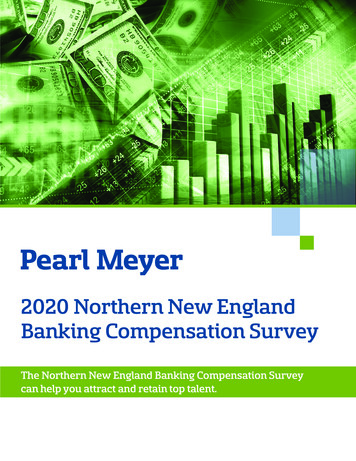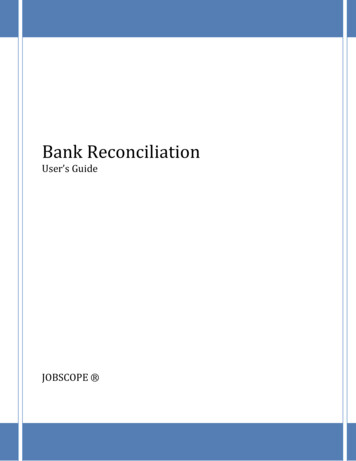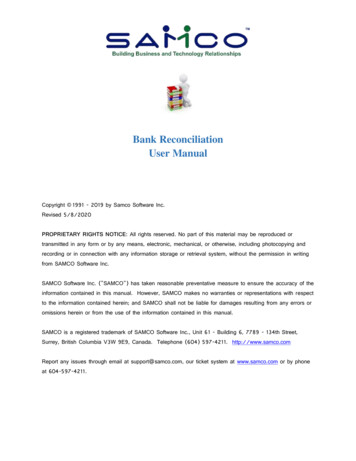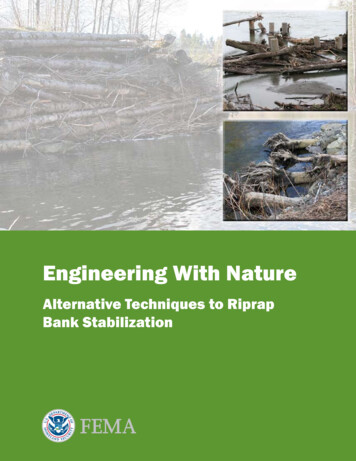
Transcription
Engineering With NatureAlternative Techniques to RiprapBank Stabilization
Engineering With NatureAlternative Techniques to Riprap Bank Stabilization
ContentsIntroduction .7Hamakami Strawberry Farm . .11Riverview Road .13Eatonville Logjams .15Burley Creek Brush Mattress .18Everson Overflow .20Hiddendale . .22Old Tarboo Road Bridge .24Black Lake Drainage Ditch .27Little Washougal Creek .29Schneider Creek .31Conclusion . .34Acknowledgements
IntroductionWe have always endeavored to harness and manipulate our environment.Efforts to shape or restrict nature often involve mechanically or artificially forcing our surroundings to bend to our will. Sadly, many of theseactivities have serious effects. Clear cutting forests, pollution, endangering entire species or simply driving them to extinction are just someof the major impacts. As we grow and develop technologically and as asociety, we often overlook just what we are doing to the land around us,frequently until it is too late.Over the past century, the Pacific Northwest has seen a significantamount of development in the areas of agriculture, housing, urbanization and population. The 12 counties spanning the area of Puget Sound inWashington State alone have seen growth in numbers of up to 4 millionpeople since the 1950s. This continuing expansion has put increased pressure on the multitude of rivers, streams and other bodies of water thatfestoon the region, and growing presence is having a marked impact onthose waters.The more development this area undergoes, the more we are forcedto restrict and inhibit the environment, in particular the varying andnumerous waterways that surround us. While land erosion, streammigration and even flooding are natural processes, they can cause havocwhen occurring near human populations. This has led to the creation of anumber of measures to control or eliminate such hazards. Unfortunately,while many of these techniques solve the immediate problem, they arenot always the safest or most environmentally conscious choice for thelong-term.Riprap, or hard armoring, is the traditional response to controlling andminimizing erosion along shorelines or riverbanks. As demonstratedby past multiple disasters in Washington State, the U.S. Department ofHomeland Security’s Federal Emergency Management Agency (FEMA)has provided funding assistance for the repair to these riprap facilities.*¹The very nature of having to repair these facilities counters the popularengineering belief that riprap is the best solution for mitigating streambank erosion.¹* Funding is contingent upon eligibility criteria established under the Robert T. StaffordDisaster Relief and Emergency Assistance Act, as amendedEngineering With Nature 7
RiprapPut simply, riprap is the layering of rocks (angular rocks generally beingpreferred,) along a threatened area to counteract the constant wearingaway of land brought about by repetitive hydrologic activity. Wheneverwaves or moving waters meet unprotected soil, there will always be erosion. Covering exposed soil with rock helps protect it from being washedaway, securing an embankment against further erosion.Problems arise because the effects of riprap do not stop at the point ofinstallation. When positioned along a section of riverbank, for example,riprap has a number of negative impacts on the surrounding environment. Riprap tends to increase the speed of water flow along an armoredreach, as the water has no points of friction to come up against andnothing to slow it down. This additional strength of flow presents issuesfurther downstream from a riprap protected bank, as water is deflectedoff the riprap and directed at other points of riverbank. The increasedstrength and speed of the water only increases erosion suffered at thesenew locations, the typical result of which is the necessity of installingadditional armoring, which merely moves the problem further down thestream.Riprap impedes the natural functions of a riverbank or shoreline, as itinterrupts the establishment of the riparian zone, or the point of interfacebetween land and flowing water. A properly functioning riparian zoneis important for a number of reasons; it can reduce stream energy andminimize erosion; filter pollutants from surface runoff via biofiltration;trap and hold sediments and woody debris, which assists in replenishingsoils and actually rebuilding banks and shorelines; and it provides habitatdiversity and an important source of aquatic nutrients. Not to mention, anaturally functioning riparian zone simply looks better.Another aspect of riprap is its considerable effect on wildlife, specificallyfish that live in and utilize streams and rivers where eroding banks haveundergone armoring. While erosion can cause potential problems forfish, especially in high-silt locations, the installation of riprap leadsto other, more significant, issues.When riprap is the primary or onlyform of riverbank stabilizationmeasure, the end result is typicallya uniform, smooth channel, with nocomplexity. This means that thereare no areas of vegetation either inor overhanging the water, leavingfish at risk from predation. In addition, a lack of riverbank diversitydenies fish a place to seek refugeduring periods of high-water, whichoften results in their being washedout of a fast moving system duringflooding.Riprap causes other, albeit less significant, problems as well. In areasof low vegetation, when exposed todirect sunlight, the rocks that comprise riprap can reflect light into8 Engineering With Nature
the water, which increases water temperatures to an unhealthy degree forfish. Riprap also tends to suffer from structural integrity issues duringand after high-water events. Losing rocks to high water or fast flows, ariprap structure will soon begin to fail in its purpose. Once the soil thatthe riprap is designed to protect is exposed, the damage continues asbefore its installation. This possibility requires constant monitoring andmaintenance, which ultimately becomes expensive and problematic.Alternative TechniquesThe old saying goes “the more things change, the more they stay thesame.” This adage, in many ways, can be applied to the discussion ofriverbank stabilization. As technologies and techniques have advanced infinding ways to secure our land from the constant ravages of erosion, webegin to see that perhaps modernizing these efforts might not be the onlyway to approach these issues.Nature has always been capable of taking care of itself. Long before webegan manipulating our environment, nature has run its own course. Is itpossible, then, that we can look to nature for examples to follow in making life near eroding or flood-prone waterways less risky while leaving asminimal a footprint as possible? Proponents of environmentally consciousand responsible construction believe so.As the realities and consequences of riprap and hard armoring riverbanks and shorelines have come to light, there are those who have begunto work towards changing the traditional approaches to erosion andflood control. New and old engineering techniques are being introducedregularly that incorporate natural functionality with modern technologyand design. Bio-engineering, hydro-seeding, controlled planting and theconstruction of engineered logjams are just some of the many efforts being taken to demonstrate the successful options that exist in the pursuitof land preservation and increased safety.Engineering With Nature 9
PurposeStandard engineering calls for hard armoring an eroding bank. Lately,the tide has turned on the accepted practice of hard armoring due topublic conscience of the eroding environment we live in. The 10 storiesin this booklet represent a handful of successful alternatives to riverbankstabilization that have been taken throughout Western Washington.While this collection is in no way complete, it offers a comprehensivelook at some of the varied techniques that are available for consideration.These best practices illustrate the fact that we can manipulate streamsand rivers without completely overriding nature’s design, that indeed, itis possible to work hand in hand with nature to make living by the waternot only viable, but much safer and secure in the long run.Selected Sites In Washington StateNooFEMA Region X GISJKELLER05/22/200820080521 Request.mxdkksacrRive! Everson OverflowWhatcom5BellinghamSan JuanOkanoganSkagitIslandClallamSnohomishOld Tarboo Road BridgeRiverview RoadEverett5! ! ! ChelanBig Quilcene RiverJefferson5ShorelineHiddendale5KitsapBurley Creek Brush MattressMasonSeattle! Kent5KingHamakami Strawberry Farm! 55Schneider CreekRentonFederal WayTacomaGrays HarborDouglasBellevue55Lakewood5! ! KittitasPierceBlack Lake Drainage DitchGrantEatonville Logjams! Thurston5LewisPacificYakimaGreen le Washougal CreekClark50 5 102030Hillsboro40Miles510 Engineering With Nature! Portland Gresham5Beaverton555VancouverYakima
Hamakami Strawberry Farm:Adding Roughness to River Keeps Farm Running SmoothlyIn 1994, King County built a bioengineered bankstabilization project on the Middle Green River atthe site of John Hamakami’s Strawberry Farm. Thesite was designed at a time when the WashingtonState Department of Fish and Wildlife, the Muckleshoot tribal fisheries groups, and King Countyecologists were realizing that the continued placement and replacement of riprap was harming fish andtheir habitat. Hamakami Strawberry Farm becamea demonstration site for the positive effects of usingnatural elements, particularly wood and vegetation,as opposed to hard armoring in a high energy riverenvironment.“We started looking at how river hydraulics wereinteracting with wood,” said Andy Levesque, a KingCounty senior engineer, who works in the River andFloodplain Management Unit. “We wanted to see howwood could be used constructively without destabilizing banks, while actually helping to direct the riverflow to make the banks more stable if possible. Theactual design and construction work was overseen byJeanne Stypula, one of our engineers, working with aconsulting biologist, Alan Johnson.”“We wanted to see how wood couldbe used constructively withoutdestabilizing banks.” - Andy LevesqueNumerous logs are placed along the toe of the riverbank.In 1990, the Middle Green River created a whole newquarter mile meander bend in just over one day. Inthe process, the river demolished 150 feet of rocklined levee, a dozen maple trees and a couple acres ofthe Hamakami Strawberry farm. Historically on theGreen River, rock riprap was used to prevent embankment scour. On such an alluvial floodplain as theHamakami property, with an abundance of silt andsand, however, slumping is the primary cause of bankfailure. Fine grained materials do not provide bankresistance, so in a high energy event, like the one thatoccurred at the Hamakami site in 1990, the GreenRiver was able to move laterally at a very rapid pace.During flooding additional woody debris is recruited by the original logs.Engineering With Nature 11
“We used wood and vegetation to slow the riverprocesses down,” said Levesque. “When the woodthat showed up in the next flood landed, it startedforming a jam. The jam evolved and recruited sediment, and the sediment recruited vegetation. Thatslowed the water down enough to deposit the gravelsupstream, which caused the river to cut multiplechannels across the bar that it had previously built.Now we’ve got 100-fold the habitat edge, variety,complexity, structure, interaction, and process thatwe did right after the flood event. We counted fish atthe site, before our installation, and there were fourof them. Now there are five different species at tendifferent times of year.”Recruited vegetation lends cohesion to the riverbanks.The 1990 flood event left a steep 10 to 15-foot high rawembankment along the Hamakami Strawberry Farm.As a result, over the following years, the farm lost asignificant amount of land to the river meander thatwas moving rapidly through the property. In fact,strawberries from the farm were literally falling intothe river channel.In 1994, King County stabilized 500 feet of the rapidlyeroding riverbank using bioengineering measures.Over 60 logs were placed along the river’s toe andsecured to the bank with coir fabric, soil wraps andvegetation. The logs were placed in groups of threeevery 20-25 feet and buried into the embankment. Asa demonstration project, the idea was to show thatinstalling natural elements addedroughness to the channel, whichincreased flow resistance andslowed the river down.“Now we’ve got 100fold the habitat edge,variety, complexity,structure, interaction,and process that wedid right after the floodevent.” - Andy Levesque12 Engineering With NatureThe Hamakami site exemplifies that if a bank stabilization design can jump-start channel processes,ecological rehabilitation will occur. The logs placedby the county now have wood, debris, sediment, andvegetation surrounding them. As a result of the project, several side channels have been created whichdistribute the system’s energy, allowing sediments todisperse and vegetation to thrive. In total, the site’secological productivity is greatly improved.“This type of technique is what I would advocate evenin a high energy environment,” said Levesque. “It canbe done with wood. It can be done with vegetation.There are some precautions that have to be takendepending on the landscape. If the river meanderhas basically cut itself to the edge of where it’s goingto go, just respect that meander belt and add somestructure back into it. Get things jump-started. Youget your process back. You get things reshaped andyou get environmental benefits.”
Riverview Road:Several Steps to Safety in Snohomish CountyRiverview Road in Snohomish County, Washingtonruns beside a section of the Snohomish River. Theroad was built by landowners in the late 1800s andthen expanded and improved in the early 1900s. Itprimarily serves the local farming communities asboth a thoroughfare and as the base of a flood controllevee system. At the time of its construction, theselevees were created with drag lines which pulled soilfrom the river bottom and deposited it on the top ofthe riverbank. The material was then flattened foruse. The pulled river soil is described as alluvial sediment and is composed of fine grained, porous material.Problems arise when such material is subject toinundation. Over the years, as the County developed,modern surfacing was laid over the old roadway originally built from the river alluvium. During periodsof high water resulting from floods on the Snohomish River, the road embankment becomes saturated.When the water recedes, the material tends to compact, and the saturated soils begin to slide down towards the river. This process often compromises thestability of the riverbank, undermining the integrityof the road itself.“This is happening at a number of places where there arelevees on the lower Snohomish River,” said Jeffrey Jones,an Engineering Geologist for Snohomish County’s PublicWorks Department. “Every time the water comes up andgoes back down, we find new problem sites.”The Riverview Road area of the Snohomish River isa migration corridor for Chinook salmon and Bulltrout, both listed under the Endangered SpeciesAct (ESA). The increase of sedimentation from thecollapsing embankment into the river was regardedas potentially harmful to fish, as sedimentation cannegatively impact oxygen levels, suffocate salmoneggs and decrease visibility for feeding. Because riprap reduces cover, increases temperature and eliminates access to spawning areas, it can have a negativeimpact on habitat. Based on these potential effectsthe team sought out other alternatives.Jones, working with Dave Lucas, a River Engineerfor the Snohomish County Surface Water Management Department, designed a system of embankmentstabilization. This environmentally-friendly designincorporated wood and vegetative plantings. Thedesign was successful because it kept the road fromcollapsing and avoided placing major amounts of rockinto the river.Since the embankment along Riverview Road is sosteep, typical stabilization techniques were impractical. Jones and his team of Snohomish County RoadMaintenance workers built a structural earth wall(SEW) composed of a number of soil wraps placed ina step-like fashion starting from the waterline andclimbing to the top of the embankment. Each step iscreated by laying down a 13-foot wide roll of polypropylene or polyethylene geo-grid fabric. The grids areThe offsetting of the soil wraps comprising the structural earth wall (SEW) give itits step-like appearance. The logs anchored to the toe of the embankment protectthe structure from fast flowing woody debris and provide habitat for migrating fishduring high water.Dave Lucas and Jeff Jones standingatop their structural earth wall onRiverview Road.Engineering With Nature 13
The first stage of the Riverview Road stabilizationproject was completed over four years ago, just downthe road from the most recent construction. At thispoint in its progression, the first area has assumed acompletely natural appearance. The planted vegetation has grown and continues to develop a functioning root system that further strengthens the embankment. The logs on the waterline have recruitedadditional woody debris, incorporating them into thehabitat, and the surface of the project is overgrown bythe hydro-seeded grass and planted vegetation. Thegeo-grids holding the embankment in place are nowcompletely invisible.The willow cuttings planted throughout the embankmentlend root cohesion and stability to the structural earth wall.weighted down by layers of compacted gravel-borrowtaken from a local quarry. The geo-grid is folded over,and another layer of gravel is used to weigh it downfurther. As each wrap is completed, the followingone is offset by at least one foot, creating the steplike appearance. The outer face of the wall is coveredwith a layer of heavy coir fabric, and topsoil which isthen hydro-seeded. This allows the geo-grid to lockin place and secure the embankment without threatof degradation from exposure to ultraviolet light.Finally, the entire embankment is planted with livewillow cuttings which ultimately take root. As thetrees grow, their root structures add to the stability ofthe embankment.According to Lucas, Snohomish County utilizes anative plant program to assist in habitat restorationprojects such as the Riverview Road effort. Not onlyare they able to determine which plants and trees areappropriate for a particular location, they also incorporate a holding facility that grows the plants to beused. With advance notice of upcoming projects, theholding facility personnel can have the plants readyand perform the recommended planting.When speaking about the success of the project,Lucas was confident in its long-term value.“Overall, this type of design will require less ongoingmaintenance than riprap,” said Lucas. “It secures theriverbank against erosion, and it helps to meet ourcommitment towards maintaining salmon habitat,a stated goal of Snohomish County. When we canadd those elements together and stabilize a Countyroad in a habitat friendly manner, I think the projectspeaks for itself.”Eventually the coir fabric and the structural earth wall itselfwill be completel
sand, however, slumping is the primary cause of bank failure. Fine grained materials do not provide bank resistance, so in a high energy event, like the one that occurred at the Hamakami site in 1990, the Green River was able to move laterally at a very rapid pace. Hamakami Strawberry Farm: Adding Roughness to River Keeps Farm Running Smoothly

